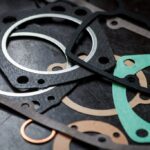Have you ever stopped to consider the intricate journey a car undertakes before it arrives at the dealership, ready for you to drive home? Creating a car is a complex process, typically spanning two to five years from initial design to market launch. This extensive timeframe is crucial for rigorous testing, ensuring vehicle safety and performance, as well as for developing innovative and appealing designs that capture consumer interest.
While the concept of the car assembly line has been refined since Henry Ford’s groundbreaking innovation, modern car manufacturing has evolved significantly. Advancements in technology and shifting consumer demands have led to more sophisticated designs and the use of increasingly complex materials.
Every car manufacturer operates with its own nuanced process, but the fundamental steps, from sourcing raw materials to showcasing the finished product in showrooms, remain broadly consistent. Let’s delve into the step-by-step process of how cars are manufactured.
Step-by-Step Car Manufacturing Process
Raw Materials: The Foundation of Every Vehicle
The journey of car manufacturing begins with raw materials. Transforming a concept into a tangible vehicle requires a diverse range of resources. Modern car manufacturers are increasingly focused on sourcing sustainable, lightweight, and cost-effective materials. This shift is driven by the growing demand for environmentally friendly vehicles and the need to improve fuel efficiency. Materials commonly used include steel and aluminum for the car’s structure, glass for windows, rubber for tires and seals, plastics for interior components, and copper for wiring. The selection and preparation of these raw materials are the critical first steps in the manufacturing process.
Alt text: Pile of various raw materials including metal sheets, rubber components, plastic granules, and glass panes used in automotive manufacturing.
Design and Engineering: Shaping the Future of Automotive
Automobile design is a dynamic process, heavily influenced by public preferences and evolving needs. The design phase is not merely about aesthetics; it’s about translating consumer desires and technological possibilities into a functional and appealing vehicle. Once an initial design concept is drafted, it undergoes numerous revisions and refinements. This iterative process aims to perfect both the interior and exterior, ensuring the car is visually attractive to potential buyers while incorporating cutting-edge technologies that set it apart from competitors.
To rigorously test design concepts, manufacturers create small-scale models in both 2D and 3D formats. Engineers then subject these models to a battery of tests, evaluating critical aspects such as aerodynamics, structural safety, performance in extreme hot and cold weather conditions, fuel efficiency, and electrical system functionality. Cost analysis is also a crucial part of this stage. Only after the design and engineering specifications receive final approval does the actual manufacturing process commence.
Alt text: Automotive designers working on 3D car model on computer screens in a design studio, showcasing the engineering and design phase of car manufacturing.
Manufacturing: From Sheet Metal to Car Body
The manufacturing stage is where the car truly begins to take shape. Robots play a crucial role in this phase, particularly in creating the sheet metal parts that form the car’s bodywork. These automated systems precisely stamp out components like side frames, doors, hoods, and roofs. These individual parts are then prepared to be assembled onto the car’s main frame, forming the vehicle’s structure.
Once the frame is constructed and the body parts are ready, the car chassis moves onto the production line. This assembly line is a constantly moving system within the manufacturing plant. As the car progresses along the line, a combination of human workers and robots work in tandem to assemble the vehicle. Manufacturing plant workers manually attach specific parts, often collaborating with robots for tasks requiring precision or heavy lifting. Specialized robotic work cells operate autonomously, performing tasks such as welding different parts together, soldering connections, screwing components into place, and applying adhesives.
After the main body of the car is assembled, it proceeds to the detailing stage. This includes a thorough cleaning process, followed by the application of protective chemical coatings. These coatings are essential for safeguarding the car against corrosion and surface scratches, ensuring longevity and maintaining its visual appeal. Finally, the painting process takes place, giving the car its desired color and finish.
Alt text: Robots welding car frames on an automated assembly line, highlighting the robotic precision in automotive body manufacturing.
Testing and Quality Assurance: Ensuring Safety and Performance
With the car body assembled and painted, the next critical phase is testing and quality assurance (QA). Now that the car is physically complete and drivable, it undergoes rigorous testing to guarantee both quality and safety standards are met.
The QA process involves multiple stages:
-
Visual Inspection: The vehicle is meticulously examined for any imperfections or inconsistencies in both the interior and exterior finish. This includes checking paint quality, panel alignment, and interior trim.
-
Performance Testing: The car is subjected to a series of functional tests, mirroring aspects of a standard driver’s test. This includes repeatedly starting and stopping the engine to check reliability, adjusting steering alignment for precision handling, verifying headlight brightness and beam reach for nighttime visibility, and comprehensive brake testing to ensure safety under various conditions.
-
Leak Testing: To ensure weatherproofing, the car is subjected to high-pressure water tests to identify any potential leaks in the seals around windows and doors.
-
Electrical and Software Checks: The car’s complex electronic systems and software programming are thoroughly tested. This ensures the safety and proper functionality of all electrical units, from infotainment systems to safety features.
-
Crash Testing: In a crucial safety assessment, crash testing is performed. This involves simulating various impact scenarios to observe the car’s structural integrity and evaluate the effectiveness of safety features like airbags and seat belts in protecting occupants.
Only after successfully passing all these stringent tests and confirming there are no required design or production adjustments for safety or performance is the car deemed ready for market release.
Alt text: Car undergoing a frontal crash test in a controlled environment, demonstrating the rigorous safety testing procedures in automotive manufacturing.
Launch: Bringing Cars to the Market
The final stage is the launch of the vehicle. Prior to mass production, extensive market research is conducted to understand consumer demand and preferences. A comprehensive marketing strategy is developed to create excitement and generate interest in the new car model. Pricing is carefully determined based on production costs, market positioning, and competitive analysis. Once these factors are finalized, mass production begins, and the vehicles are distributed to car dealerships and private dealers. From there, the cars become available for purchase by the public, completing the long and complex journey from concept to consumer.
Alt text: Newly manufactured cars being displayed at a launch event, ready for distribution to dealerships and public sale.
Cars: A Testament to Engineering and Innovation
Cars are more than just a mode of transport; they represent a remarkable feat of engineering and cutting-edge technology. While commonplace in modern life, the automobile is a product of immense complexity and innovation that has fundamentally reshaped how we live and travel.
Understanding the intricate process of car manufacturing, from initial design to final launch, provides a deeper appreciation for the sophisticated engineering and functionality embedded in every vehicle on the road today.

